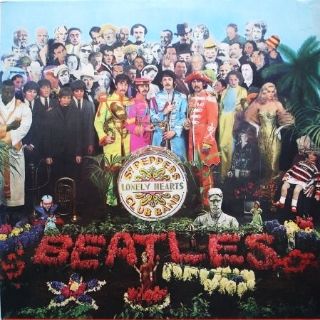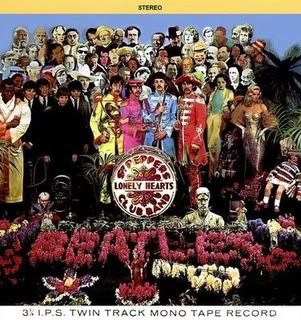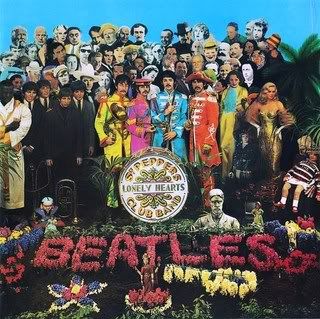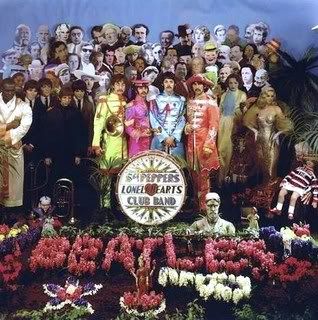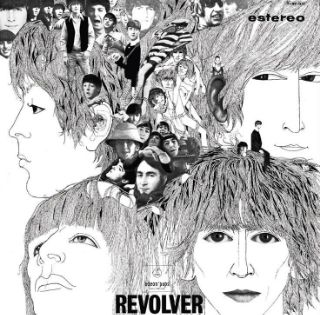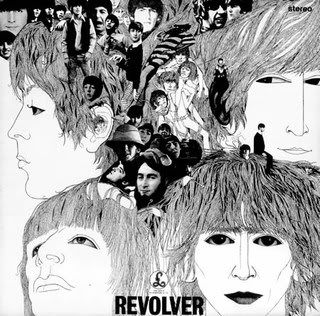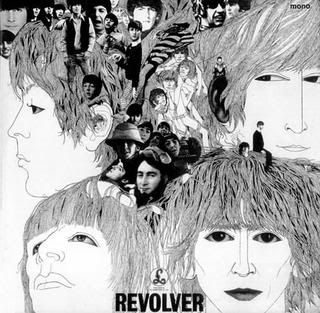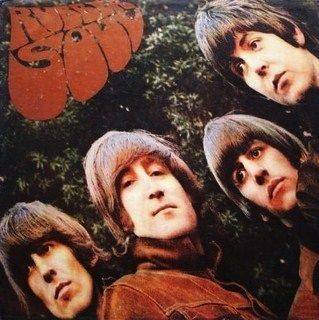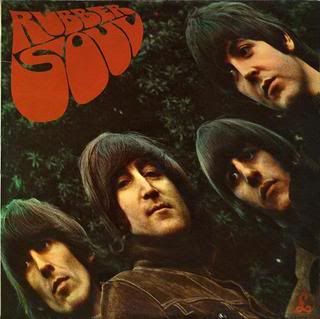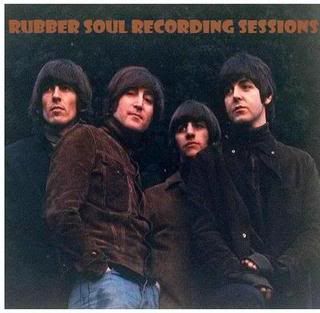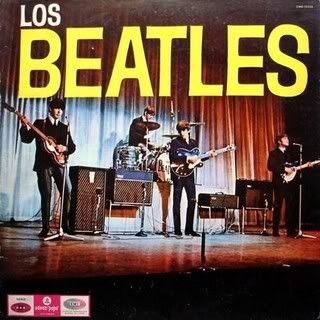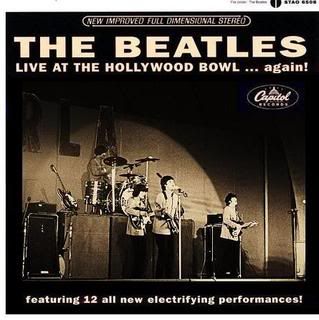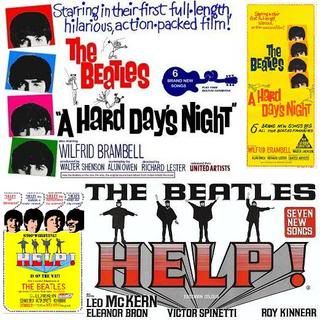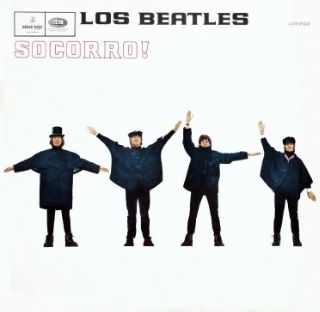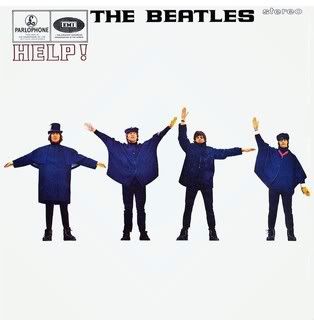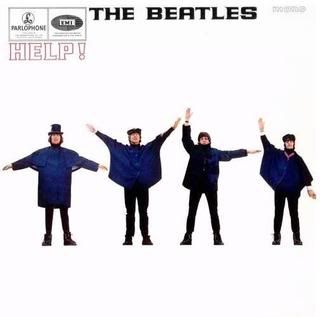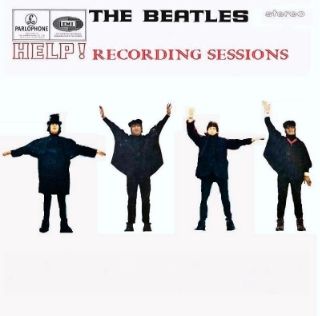Recording first published 14 July 1967, mono & stereo.
"Nuestras grabaciones serán cada vez más perfectas y encontrarán en ustedes oyentes cordiales e interesados"
viernes, 29 de marzo de 2013
· "SGT. PEPPER'S L.H.C.B." - Mono mixes in Stereo - The Beatles
I don't know how they did this, but they did it...
This is the mono mix of Sgt.Pepper presented in stereo by Mirror Spock.
01- Sgt. Pepper's Lonely Hearts Club Band
02- With a Little Help From My Friends
03- Lucy in the Sky with Diamonds
04- Getting Better
05- Fixing a Hole
06- She's Leaving Home
07- Being For The Benefit Of Mr. Kite!
08- Within You Without You
09- When I'm Sixty-Four
10- Lovely Rita
11- Good Morning Good Morning
12- Sgt. Pepper's Lonely Hearts Club Band (Reprise)
13- A Day in the Life
14- Coda
This is the mono mix of Sgt.Pepper presented in stereo by Mirror Spock.
01- Sgt. Pepper's Lonely Hearts Club Band
02- With a Little Help From My Friends
03- Lucy in the Sky with Diamonds
04- Getting Better
05- Fixing a Hole
06- She's Leaving Home
07- Being For The Benefit Of Mr. Kite!
08- Within You Without You
09- When I'm Sixty-Four
10- Lovely Rita
11- Good Morning Good Morning
12- Sgt. Pepper's Lonely Hearts Club Band (Reprise)
13- A Day in the Life
14- Coda
· "SGT. PEPPER'S L.H.C.B." LP stereo
This is the most common stereo version...
01- Sgt. Pepper's Lonely Hearts Club Band
02- With A Little Help From My Friends
03- Lucy In The Sky With Diamonds
04- Getting Better
05- Fixing A Hole
06- She's Leaving Home
07- Being For The Benefit Of Mr. Kite!
08- Within You Without You
09- When I'm Sixty-Four
10- Lovely Rita
11- Good Morning Good Morning
12- Sgt. Pepper's Lonely Hearts Club Band (Reprise)
13- A Day In The Life
01- Sgt. Pepper's Lonely Hearts Club Band
02- With A Little Help From My Friends
03- Lucy In The Sky With Diamonds
04- Getting Better
05- Fixing A Hole
06- She's Leaving Home
07- Being For The Benefit Of Mr. Kite!
08- Within You Without You
09- When I'm Sixty-Four
10- Lovely Rita
11- Good Morning Good Morning
12- Sgt. Pepper's Lonely Hearts Club Band (Reprise)
13- A Day In The Life
· "SGT. PEPPER'S L.H.C.B." LP mono
Sgt. Pepper's Lonely Hearts Club Band was released on 1 June 1967 in the United Kingdom. "Sgt. Pepper" is often described as The Beatles' magnum opus, and recognized as one of the most influential albums of all time by prominent critics and publications. It was ranked the greatest album of all time by Rolling Stone in 2003.
"You've never really heard Sgt Pepper until you've heard it in mono." - Sir George Martin, Beatles' record producer and arranger.
Please, read the following information regarding the sonic differences found between a MONO vs. STEREO copies of Sgt. Pepper:
· The funky backwards guitar part at the end of the opening song just before "Billy Shears."
· The flangey/ADT effect on Ringo's voice during some chorus of "With A Little Help From My Friends."
· The tripped out flangey vocals from the second verse out on "Lucy In The Sky With Diamonds."
· The slightly longer end of "Fixing A Hole" where McCartney is wailing up high.
· The change in tone in "She's leaving home" in the mono version - due to being sped up, not so dreary and long as in the stereo version.
· The timing on the effects of "Mr. Kite."
· The extended louder laughter on "Within You Without You."
· The louder backing "oo-oo's" on "When I'm 64".
· The "bleed edit" found at the beginning of the "Sgt. Pepper Reprise"; you can hear the machine flutter as it comes out of pause.
· The low volume mumbo jumbo during the extended bass drum raps at the beginning of the "Sgt. Pepper Reprise".
· The timing of the audiences are different on the "Reprise" section.
· Paul McCartney ad libbing at the end. Paul sound like he is saying "Thank you very much good night now..." or "bye bye now".
Now, judge yourselves...
01- Sgt. Pepper's Lonely Hearts Club Band
02- With A Little Help From My Friends
03- Lucy In The Sky With Diamonds
04- Getting Better
05- Fixing A Hole
06- She's Leaving Home
07- Being For The Benefit Of Mr. Kite!
08- Within You Without You
09- When I'm Sixty-Four
10- Lovely Rita
11- Good Morning Good Morning
12- Sgt. Pepper's Lonely Hearts Club Band (Reprise)
13- A Day In The Life
"You've never really heard Sgt Pepper until you've heard it in mono." - Sir George Martin, Beatles' record producer and arranger.
Please, read the following information regarding the sonic differences found between a MONO vs. STEREO copies of Sgt. Pepper:
· The funky backwards guitar part at the end of the opening song just before "Billy Shears."
· The flangey/ADT effect on Ringo's voice during some chorus of "With A Little Help From My Friends."
· The tripped out flangey vocals from the second verse out on "Lucy In The Sky With Diamonds."
· The slightly longer end of "Fixing A Hole" where McCartney is wailing up high.
· The change in tone in "She's leaving home" in the mono version - due to being sped up, not so dreary and long as in the stereo version.
· The timing on the effects of "Mr. Kite."
· The extended louder laughter on "Within You Without You."
· The louder backing "oo-oo's" on "When I'm 64".
· The "bleed edit" found at the beginning of the "Sgt. Pepper Reprise"; you can hear the machine flutter as it comes out of pause.
· The low volume mumbo jumbo during the extended bass drum raps at the beginning of the "Sgt. Pepper Reprise".
· The timing of the audiences are different on the "Reprise" section.
· Paul McCartney ad libbing at the end. Paul sound like he is saying "Thank you very much good night now..." or "bye bye now".
Now, judge yourselves...
01- Sgt. Pepper's Lonely Hearts Club Band
02- With A Little Help From My Friends
03- Lucy In The Sky With Diamonds
04- Getting Better
05- Fixing A Hole
06- She's Leaving Home
07- Being For The Benefit Of Mr. Kite!
08- Within You Without You
09- When I'm Sixty-Four
10- Lovely Rita
11- Good Morning Good Morning
12- Sgt. Pepper's Lonely Hearts Club Band (Reprise)
13- A Day In The Life
· "SGT. PEPPER'S MULTI-TRACK MASTERS" - The Beatles
"Sgt. Pepper's Lonely Hearts Club Band" is the eighth studio album by The Beatles. It was recorded over a 129-day period beginning on 6 December 1966. Since the introduction of magnetic recording tape in 1949, multitrack recording had been developed. By 1967 all of the Sgt. Pepper tracks could be recorded at Abbey Road using mono, stereo and 4-track recorders. Although 8-track tape recorders were already available in the U.S., the first 8-tracks were not operational in commercial studios in London until late 1967, shortly after "Sgt. Pepper's L.H.C.B." was released. In retrospect, the limitations of EMI's studio technology most likely pushed the Beatles and their production staff to be more inventive and resourceful than they otherwise would have been. Like its predecessors, this recording made extensive use of the technique known as bouncing down (also called multing), in which a number of tracks were recorded across the four tracks of one recorder, which were then mixed and dubbed down onto one track of the master 4-track machine (reduction). This procedure enabled the Abbey Road engineers to give the Beatles a virtual multi-track studio. So here you have four songs from the original 4-track master tape which are featured track-by-track, plus some other additional stuff as Bonus Tracks. Hope you enjoy them.
1-“A Day In The Life” *
10 Feb 67 - E63175 (take 7)
track 1 - piano, guitar, maracas, bongos, alarm clock
track 2 - reduction of: John vocal, Mal counting, Paul vocal (redone), John & Paul "ahhs", piano
track 3 - bass, drums (redone), tambourine
track 4 - sync tone (orchestra)
track 5 - full multi-track stereo mix
Basic recording: 19 Jan 1967
Additional recording: 19-20 Jan, 3-10-22 Feb 1967
Master tape: 4 track 2nd generation + 4 track [2 tapes]
Mono-mixed: Mix A: 22 Feb 1967. Edited-Crossfaded: 6 Apr 1967
Stereo-mixed: Mix B: 23 Feb 1967. Edited-Crossfaded: 20 Apr 1967
New mix: 1995. Edited
The orchestra was recorded on 4 tracks of a separate 4-track tape [take 7] and synchronized during mixing with the Beatles tape [take 6]. The edit is for the final note, recorded separately. The crossfade joins the beginning to the preceding song, "Sgt Pepper Reprise". For the "1967-1970" collection and on a 1978 single, the crossfade is just cut off, so the song begins later than its real beginning. The original mix, without crossfade, appeared on the film soundtrack LP and CD "Imagine: John Lennon". The same original mix, also including a countdown that is not heard under the crossfade, appeared in a 1967 promo film.
2-"Sgt. Pepper’s Lonely Hearts Club Band" *
6 Mar 67 - E63022 (take 10)
track 1 - reduction of: instrumental backing + bass
track 2 - atmosphere (tuning and audience)
track 3 - brass + lead guitar
track 4 - reduction of: lead and chorus vocals + harmony vocals
track 5 - full multi-track stereo mix
Basic recording: 1 Feb 1967
Additional recording: 1-2 Feb, 3-6 Mar 1967
Master tape: 4 track 2nd generation
Mono-mixed: 6 Mar 1967. Crossfaded: 6 Apr 1967
Stereo-mixed: 6 Mar 1967. Crossfaded: 7 Apr 1967
Re-mastered and re-mixed again: 1999 for the "Yellow Submarine Songtrack"
The crossfade joins this song to “With a Little Help From My Friends”. The lead guitar starting around "I don't really want to stop the show" is louder in the mono mix, while barely there in stereo. The crowd noise differs between the two and the crossfade is less well hidden in mono. The Yellow Submarine Songtrack mix re-synchs the old multitracks again and brings us a cleaner version, this time in richer stereo than on the original "Sgt. Pepper" stereo LP. Paul's vocals and Ringo's drums are centered, while the backing vocals and the sound of the crowd has been moved about a bit.
3-"She's Leaving Home" *
20 Mar 67 - E63631 (take 9)
track 1 - reduction of: harp + violins
track 2 - reduction of: double bass + 2 violas + 2 cellos
track 3 - vocals
track 4 - harmony vocals
track 5 - full multi-track stereo mix
Basic recording: 17 Mar 1967
Additional recording: 20 Mar 1967
Master tape: 4 track 2nd generation
Mono-mixed: 20 Mar 1967. Edited
Stereo-mixed: 17 Apr 1967. Edited
A short amount of instrumental work between the verses was removed after the mixing was done, so both mixes are edited. Reverb had been added during mixing, and the edits are a little more obvious in stereo, just before Paul starts singing the second and third verses. The two mixes are at different speeds since mono mix was speeded up.
4-"With A Little Help From My Friends" *
30 Mar 67 - E63462 (take 11)
track 1 - reduction of: piano, guitar, drums, cowbell and organ intro
track 2 - guitar piece, tambourine, bass, drum intro
track 3 - Ringo vocal, John & Paul vocal
track 4 - John & Paul vocals, organ intro, guitar piece
track 5 - full multi-track stereo mix
Basic recording: 29 Mar 1967
Additional recording: 29-30 Mar 1967
Master tape: 4 track 3rd generation
Mono-mixed: 31 Mar 1967. Crossfaded: 6 Apr 1967
Stereo-mixed: 7 Apr 1967. Crossfaded: 7 Apr 1967.
Re-mastered and re-mixed again: 1999 for the "Yellow Submarine Songtrack"
The crossfade joins this to the preceding song, “Sgt Pepper”, but the songs do not overlap; rather, crowd noise runs from one through to the other. This song starts right before the announcement "Billy Shears!", which is more readily apparent as a change in ambience in mono, since louder crowd noise covers the join better in stereo. The "Yellow Submarine Songtrack" mix re-synchs the old multitracks again and brings us a cleaner version, this time in richer stereo than on the original "Sgt. Pepper" stereo LP. Vocals and drums has especially benefitted from this mix.
5- Bonus Tracks:
track 21 – When I’m 64 (take 4 - Original speed)
track 22 – Good Morning, Good Morning (take 4 - No overdubs )
track 23 – Sgt Pepper's Lonely Hearts Club Band (Full ending)
track 24 – Strawberry Fields Forever (take 1 - Complete)
track 25 – Strawberry Fields Forever (take 7 - Best heavy version)
track 26 – Strawberry Fields Forever (take 26 - Best orchestrated version)
track 27 – Strawberry Fields Forever (Final version - From edited takes 7 & 26)
track 28 – Penny Lane I
track 29 - Penny Lane II
track 30 – Penny Lane III
1-“A Day In The Life” *
10 Feb 67 - E63175 (take 7)
track 1 - piano, guitar, maracas, bongos, alarm clock
track 2 - reduction of: John vocal, Mal counting, Paul vocal (redone), John & Paul "ahhs", piano
track 3 - bass, drums (redone), tambourine
track 4 - sync tone (orchestra)
track 5 - full multi-track stereo mix
Basic recording: 19 Jan 1967
Additional recording: 19-20 Jan, 3-10-22 Feb 1967
Master tape: 4 track 2nd generation + 4 track [2 tapes]
Mono-mixed: Mix A: 22 Feb 1967. Edited-Crossfaded: 6 Apr 1967
Stereo-mixed: Mix B: 23 Feb 1967. Edited-Crossfaded: 20 Apr 1967
New mix: 1995. Edited
The orchestra was recorded on 4 tracks of a separate 4-track tape [take 7] and synchronized during mixing with the Beatles tape [take 6]. The edit is for the final note, recorded separately. The crossfade joins the beginning to the preceding song, "Sgt Pepper Reprise". For the "1967-1970" collection and on a 1978 single, the crossfade is just cut off, so the song begins later than its real beginning. The original mix, without crossfade, appeared on the film soundtrack LP and CD "Imagine: John Lennon". The same original mix, also including a countdown that is not heard under the crossfade, appeared in a 1967 promo film.
2-"Sgt. Pepper’s Lonely Hearts Club Band" *
6 Mar 67 - E63022 (take 10)
track 1 - reduction of: instrumental backing + bass
track 2 - atmosphere (tuning and audience)
track 3 - brass + lead guitar
track 4 - reduction of: lead and chorus vocals + harmony vocals
track 5 - full multi-track stereo mix
Basic recording: 1 Feb 1967
Additional recording: 1-2 Feb, 3-6 Mar 1967
Master tape: 4 track 2nd generation
Mono-mixed: 6 Mar 1967. Crossfaded: 6 Apr 1967
Stereo-mixed: 6 Mar 1967. Crossfaded: 7 Apr 1967
Re-mastered and re-mixed again: 1999 for the "Yellow Submarine Songtrack"
The crossfade joins this song to “With a Little Help From My Friends”. The lead guitar starting around "I don't really want to stop the show" is louder in the mono mix, while barely there in stereo. The crowd noise differs between the two and the crossfade is less well hidden in mono. The Yellow Submarine Songtrack mix re-synchs the old multitracks again and brings us a cleaner version, this time in richer stereo than on the original "Sgt. Pepper" stereo LP. Paul's vocals and Ringo's drums are centered, while the backing vocals and the sound of the crowd has been moved about a bit.
3-"She's Leaving Home" *
20 Mar 67 - E63631 (take 9)
track 1 - reduction of: harp + violins
track 2 - reduction of: double bass + 2 violas + 2 cellos
track 3 - vocals
track 4 - harmony vocals
track 5 - full multi-track stereo mix
Basic recording: 17 Mar 1967
Additional recording: 20 Mar 1967
Master tape: 4 track 2nd generation
Mono-mixed: 20 Mar 1967. Edited
Stereo-mixed: 17 Apr 1967. Edited
A short amount of instrumental work between the verses was removed after the mixing was done, so both mixes are edited. Reverb had been added during mixing, and the edits are a little more obvious in stereo, just before Paul starts singing the second and third verses. The two mixes are at different speeds since mono mix was speeded up.
4-"With A Little Help From My Friends" *
30 Mar 67 - E63462 (take 11)
track 1 - reduction of: piano, guitar, drums, cowbell and organ intro
track 2 - guitar piece, tambourine, bass, drum intro
track 3 - Ringo vocal, John & Paul vocal
track 4 - John & Paul vocals, organ intro, guitar piece
track 5 - full multi-track stereo mix
Basic recording: 29 Mar 1967
Additional recording: 29-30 Mar 1967
Master tape: 4 track 3rd generation
Mono-mixed: 31 Mar 1967. Crossfaded: 6 Apr 1967
Stereo-mixed: 7 Apr 1967. Crossfaded: 7 Apr 1967.
Re-mastered and re-mixed again: 1999 for the "Yellow Submarine Songtrack"
The crossfade joins this to the preceding song, “Sgt Pepper”, but the songs do not overlap; rather, crowd noise runs from one through to the other. This song starts right before the announcement "Billy Shears!", which is more readily apparent as a change in ambience in mono, since louder crowd noise covers the join better in stereo. The "Yellow Submarine Songtrack" mix re-synchs the old multitracks again and brings us a cleaner version, this time in richer stereo than on the original "Sgt. Pepper" stereo LP. Vocals and drums has especially benefitted from this mix.
5- Bonus Tracks:
track 21 – When I’m 64 (take 4 - Original speed)
track 22 – Good Morning, Good Morning (take 4 - No overdubs )
track 23 – Sgt Pepper's Lonely Hearts Club Band (Full ending)
track 24 – Strawberry Fields Forever (take 1 - Complete)
track 25 – Strawberry Fields Forever (take 7 - Best heavy version)
track 26 – Strawberry Fields Forever (take 26 - Best orchestrated version)
track 27 – Strawberry Fields Forever (Final version - From edited takes 7 & 26)
track 28 – Penny Lane I
track 29 - Penny Lane II
track 30 – Penny Lane III
Etiquetas:
Abbey Road studios,
Beatles,
recording sessions,
stereo
sábado, 23 de marzo de 2013
· "REVOLVER" (Argentinian LP)
· "REVOLVER" - The Beatles USA 1966
The original US LP release of Revolver, the band's tenth on Capitol Records and twelfth US album, marked the last time Capitol would release an altered UK Beatles album for the US market. As three of its tracks—"I'm Only Sleeping", "And Your Bird Can Sing" and "Doctor Robert"—had been used for the earlier Yesterday... And Today Capitol compilation, they were simply removed in the US version, yielding an 11 track album instead of the UK version's 14 and shortening the time to 28:20. The album's 30 April 1987 release on CD in USA standardised the track listing to the original UK version. Having been available only as an import in the US in the past, the 14 track UK version of the album was also issued domestically in the US on LP and cassette on 21 July 1987. The CD was remastered in 2009. The US version has never been available on that format.
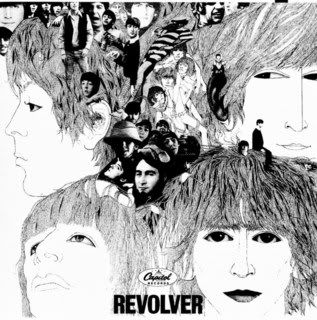
Mono: https://mega.co.nz/#!qUVimAjB!DKiT0QkBbCgMwc4lwrpqXTplwzEKyW4TQ232FLC1aF0
Stereo: https://mega.co.nz/#!7IMnzR5a!aFt_zmFzBN1s4wxmnYgBWFl4RZgu73M3XaKSk5CfEzs
01- Taxman
02- Eleanor Rigby
03- Love You To
04- Here, There and Everywhere
05- Yellow Submarine
06- She Said, She Said
07- Good Day Sunshine
08- For No One
09- I Want To Tell You
10- Got To Get You Into My Life
11- Tomorrow Never Knows

Mono: https://mega.co.nz/#!qUVimAjB!DKiT0QkBbCgMwc4lwrpqXTplwzEKyW4TQ232FLC1aF0
Stereo: https://mega.co.nz/#!7IMnzR5a!aFt_zmFzBN1s4wxmnYgBWFl4RZgu73M3XaKSk5CfEzs
01- Taxman
02- Eleanor Rigby
03- Love You To
04- Here, There and Everywhere
05- Yellow Submarine
06- She Said, She Said
07- Good Day Sunshine
08- For No One
09- I Want To Tell You
10- Got To Get You Into My Life
11- Tomorrow Never Knows
· "REVOLVER" LP stereo
UK stereo master.
01- Taxman
02- Eleanor Rigby
03- I'm Only Sleeping
04- Love You To
05- Here, There and Everywhere
06- Yellow Submarine
07- She Said, She Said
08- Good Day Sunshine
09- And Your Bird Can Sing
10- For No One
11- Dr. Robert
12- I Want To Tell You
13- Got To Get You Into My Life
14- Tomorrow Never Knows
01- Taxman
02- Eleanor Rigby
03- I'm Only Sleeping
04- Love You To
05- Here, There and Everywhere
06- Yellow Submarine
07- She Said, She Said
08- Good Day Sunshine
09- And Your Bird Can Sing
10- For No One
11- Dr. Robert
12- I Want To Tell You
13- Got To Get You Into My Life
14- Tomorrow Never Knows
· "REVOLVER" LP mono
Revolver is the seventh album by The Beatles, released on 5 August 1966. Many of the tracks on Revolver are marked by an electric guitar-rock sound, in contrast with their previous, folk rock inspired Rubber Soul. It reached #1 on the UK chart for seven weeks and #1 on the U.S. chart for six weeks. It was released before the Beatles' last tour in August 1966, but they did not perform songs from the album live. Their reasoning for this was that many of the tracks on the album, for example "Tomorrow Never Knows", were too complex to perform with live instruments. Revolver is often regarded as The Beatles' greatest studio album, perhaps matched only by Sgt. Pepper's Lonely Hearts Club Band (1967). In many respects, Revolver is one of the very first psychodelic LPs, not only in its numerous shifts in mood and production texture, but in its innovative manipulation of amplification and electronics to produce new sounds on guitars and other instruments. Revolver is often cited as one of the greatest albums in rock music history. In 1997, it was named the 3rd greatest album of all time in a 'Music of the Millennium' poll conducted in the United Kingdom by HMV Group, Channel 4, The Guardian and Classic FM. In 2006, Q magazine readers placed it at number 4, while in 2000 the same magazine placed it at number 1 in its list of the 100 Greatest British Albums Ever. In 2001 the TV network VH1 named it the number 1 greatest album of all time, a position it also achieved in the Virgin All Time Top 1,000 Albums. A PopMatters review described the album as "the individual members of the greatest band in the history of pop music peaking at the exact same time", while Ink Blot magazine claims it "stands at the summit of western pop music." In 2002, the readers of Rolling Stone ranked the album the greatest of all time. In 2003, the album was ranked number 3 on Rolling Stone magazine's list of the 500 greatest albums of all time. It was ranked 10th on Guitar World's (Readers Choice) Greatest 100 Guitar Albums of All Time. And in 2006, the album was chosen by Time magazine as one of the 100 best albums of all time.
01- Taxman
02- Eleanor Rigby
03- I'm Only Sleeping
04- Love You To
05- Here, There and Everywhere
06- Yellow Submarine
07- She Said, She Said
08- Good Day Sunshine
09- And Your Bird Can Sing
10- For No One
11- Dr. Robert
12- I Want To Tell You
13- Got To Get You Into My Life
14- Tomorrow Never Knows
01- Taxman
02- Eleanor Rigby
03- I'm Only Sleeping
04- Love You To
05- Here, There and Everywhere
06- Yellow Submarine
07- She Said, She Said
08- Good Day Sunshine
09- And Your Bird Can Sing
10- For No One
11- Dr. Robert
12- I Want To Tell You
13- Got To Get You Into My Life
14- Tomorrow Never Knows
· "YESTERDAY... AND TODAY" - The Beatles USA 1966
Yesterday and Today (rendered as "Yesterday… And Today" on the record label and in most published discographies) is the tenth Capitol release by the The Beatles and the twelfth overall U.S. release. It was issued only in the United States and Canada. The album is remembered primarily for the controversy surrounding its original cover image, the "butcher cover" featuring the band dressed in white smocks and covered with decapitated baby dolls and pieces of meat. Probably this is the reason why it’ll never be released officially on CD format. This album saw the release of all of the tracks from the previous two British releases that were not included on their American counterparts: Help! ("Act Naturally" and "Yesterday") and Rubber Soul ("Drive My Car", "Nowhere Man", "If I Needed Someone", and "What Goes On"). The recent single "Day Tripper" / "We Can Work It Out" was also included, as were three tracks from the upcoming LP, Revolver: "I'm Only Sleeping", "Doctor Robert", and "And Your Bird Can Sing", issued here in preliminary mixes. This cutting up of their albums irritated the Beatles, who felt they had "put a lot of work into the sequencing" of the British versions. In fact, “Revolver” and this album were to be the last examples of this practice. Released in June 1966, a short time before what would be their last tour, this album's controversial cover marked the first time that the Beatles' judgment was severely criticized by the media and the public. Nevertheless, the album reached #1 on the U.S. Billboard charts by July 30, 1966 and was certified gold soon after. Apart from the so-called butcher cover, this album is of interest to collectors for the appearance of unique mixes tracks unavailable elsewhere. Because of Capitol Records' haste to release new product, mono and stereo pre-mixes of "Dr. Robert", "And Your Bird Can Sing", and "I'm Only Sleeping" were made for the US and sent by Martin specifically for this album; also the stereo mixes of "Day Tripper" (mixed October 26,1965) and "We Can Work It Out" featured here (both mixed on November 10, 1965 and then scrapped on August 09, 1966 from Abbey Road vaults) differ from the UK official stereo mixes which were done sometime later that year (November 10, 1966) specifically for the British compilation Oldies… But Goldies, so these included here (I mean officially only here) are the original 1965 mixes which were later discarded for all later releases.
01- Drive My Car
02- I'm Only Sleeping
03- Nowhere Man
04- Dr. Robert
05- Yesterday
06- Act Naturally
07-And Your Bird Can Sing
08- If I Needed Someone
09- We Can Work It Out
10- What Goes On?
11- Day Tripper
01- Drive My Car
02- I'm Only Sleeping
03- Nowhere Man
04- Dr. Robert
05- Yesterday
06- Act Naturally
07-And Your Bird Can Sing
08- If I Needed Someone
09- We Can Work It Out
10- What Goes On?
11- Day Tripper
· "REVOLVER" LP recording sessions
1966 was probably their most creative era, though that year the group would release only one LP...
6 April, 1966 - 8:00pm-1:15am. - EMI Studio 3
01- Mark I [Tomorrow Never Knows] (take 1 - complete)
7 April, 1966 - 8:15pm-1:30am. - EMI Studio 3
02- Got To Get You Into My Life (take 5 - complete)
13 - 14 April, 1966 - 2:30-7:30pm. + 2:30-7:30pm. - EMI Studio 3
03- Paperback Writer (take 1 - breakdown)
04- Paperback Writer (take 2 - complete)
20 April, 1966 - 2:30pm-2:30am. - EMI Studio 2
05- And Your Bird Can Sing (take 2 - complete)
06- And Your Bird Can Sing (take 2 + overdubs)
21 April, 1966 - 2:30pm-12:50am. - EMI Studio 2
07- Taxman (take 11 - complete)
08- Taxman (SI onto take 12)
26 April, 1966 - 2:30pm-2:45am. - EMI Studio 2
09- And Your Bird Can Sing (take 10)
28 April, 1966 - 5:00-7:50pm. - EMI Studio 2
10- Eleanor Rigby (take 14 - complete)
29 April, 1966 - 5:00pm-1:00am. - EMI Studio 2
11- I'm Only Sleeping (rehearsal - breakdown)
12- I'm Only Sleeping (remake Take 1 - complete)
9 May, 1966 - 7:00-11:00pm. - EMI Studio 2
13- For No One (rehearsal]
14- For No One (take 1 - breakdown)
15- For No One (take 2 - breakdown)
16 May, 1966 - 2:30pm-1:30am. - EMI Studio 2
16- For No One (a - partial)
17- For No One (b - partial)
18- For No One (c - partial)
19- For No One (take 10 - complete)
19 May, 1966 - 7:00-11:00pm. - EMI Studio 3
20- For No One (take 14 - complete)
26 May, 1966 - 2:30pm-2:30am. - EMI Studio 2
21- Yellow Submarine (take 5)
22- Yellow Submarine (take 5 with intro)
16 - 17 June, 1966 - 8:30pm-3:30am. + 7:00pm-1:30am. - EMI Studio 2
23- Here, There and Everywhere (edit take 7 + 14 - complete)
24- Here, There and Everywhere (take 14 - complete)
Alternate Mixes:
25- Got To Get You Into My Life (take 5)
26- And Your Bird Can Sing (take 2)
27- And Your Bird Can Sing (take 2 + overdubs)
Monitor Mixes:
28- Mark I [Tomorrow Never Knows)] (take 1)
29- Tomorrow Never Knows (take 3)
30- For No One (take 10a)
31- For No One (take 10b)
32- For No One (take 10c)
33- For No One (take 14)
34- Here, There and Everywhere (take 14a)
35- Here, There and Everywhere (take 14b)
36- Here, There and Everywhere (take 14c)
37- Here, There and Everywhere (take 14d)
Bonus Tracks:
38- Rain (basic track - original recording speed)
39- Rain (take 7)
6 April, 1966 - 8:00pm-1:15am. - EMI Studio 3
01- Mark I [Tomorrow Never Knows] (take 1 - complete)
7 April, 1966 - 8:15pm-1:30am. - EMI Studio 3
02- Got To Get You Into My Life (take 5 - complete)
13 - 14 April, 1966 - 2:30-7:30pm. + 2:30-7:30pm. - EMI Studio 3
03- Paperback Writer (take 1 - breakdown)
04- Paperback Writer (take 2 - complete)
20 April, 1966 - 2:30pm-2:30am. - EMI Studio 2
05- And Your Bird Can Sing (take 2 - complete)
06- And Your Bird Can Sing (take 2 + overdubs)
21 April, 1966 - 2:30pm-12:50am. - EMI Studio 2
07- Taxman (take 11 - complete)
08- Taxman (SI onto take 12)
26 April, 1966 - 2:30pm-2:45am. - EMI Studio 2
09- And Your Bird Can Sing (take 10)
28 April, 1966 - 5:00-7:50pm. - EMI Studio 2
10- Eleanor Rigby (take 14 - complete)
29 April, 1966 - 5:00pm-1:00am. - EMI Studio 2
11- I'm Only Sleeping (rehearsal - breakdown)
12- I'm Only Sleeping (remake Take 1 - complete)
9 May, 1966 - 7:00-11:00pm. - EMI Studio 2
13- For No One (rehearsal]
14- For No One (take 1 - breakdown)
15- For No One (take 2 - breakdown)
16 May, 1966 - 2:30pm-1:30am. - EMI Studio 2
16- For No One (a - partial)
17- For No One (b - partial)
18- For No One (c - partial)
19- For No One (take 10 - complete)
19 May, 1966 - 7:00-11:00pm. - EMI Studio 3
20- For No One (take 14 - complete)
26 May, 1966 - 2:30pm-2:30am. - EMI Studio 2
21- Yellow Submarine (take 5)
22- Yellow Submarine (take 5 with intro)
16 - 17 June, 1966 - 8:30pm-3:30am. + 7:00pm-1:30am. - EMI Studio 2
23- Here, There and Everywhere (edit take 7 + 14 - complete)
24- Here, There and Everywhere (take 14 - complete)
Alternate Mixes:
25- Got To Get You Into My Life (take 5)
26- And Your Bird Can Sing (take 2)
27- And Your Bird Can Sing (take 2 + overdubs)
Monitor Mixes:
28- Mark I [Tomorrow Never Knows)] (take 1)
29- Tomorrow Never Knows (take 3)
30- For No One (take 10a)
31- For No One (take 10b)
32- For No One (take 10c)
33- For No One (take 14)
34- Here, There and Everywhere (take 14a)
35- Here, There and Everywhere (take 14b)
36- Here, There and Everywhere (take 14c)
37- Here, There and Everywhere (take 14d)
Bonus Tracks:
38- Rain (basic track - original recording speed)
39- Rain (take 7)
Etiquetas:
Abbey Road studios,
Beatles,
recording sessions
sábado, 16 de marzo de 2013
· "RUBBER SOUL" - The Beatles USA 1965
Rubber Soul, the ninth Capitol Records album and eleventh official US release (T-2442 & ST-2442), came out in the United States three days after the British release, and began its 59-week long chart run on Christmas Day. It topped the charts for six weeks from 8 January 1966, before dropping back. The album sold 1.2 million copies within nine days of its release, and to date has sold over six million copies in America. Like other pre-Sgt. Pepper Beatles albums, Rubber Soul differed markedly in its US and UK configurations; indeed, through peculiarities of sequencing, the US Rubber Soul was deliberately reconfigured to appear a "folk rock" album to angle The Beatles into that emerging and lucrative American genre during 1965, thanks to the addition of "I've Just Seen a Face" and "It's Only Love" (leftovers from the UK Help!) and the deletion of some of the more upbeat tracks ("Drive My Car", "Nowhere Man", "If I Needed Someone", and "What Goes On"). The tracks missing on the US version would later surface on the Yesterday and Today collection (with "Nowhere Man" and "What Goes On" being released on a single in the meantime). The track variation resulted in a shorter album length, clocking in at 29:59. In addition, the stereo mix sent to the US from England has what are commonly called "a false start" at the beginning of "I'm Looking Through You." The track is also slightly shorter at the end. The false starts are on every American stereo copy of the album from 1965 to 1990 and are also on the CD boxed set, The Capitol Albums Vol. 2. The US version of "The Word" is also recognisably different because it has Lennon's double-tracked vocals, an extra falsetto harmony on the left channel during the last two refrains, maracas panning to the right channel during the instrumental break and then back to the left channel and the fade is a little longer. Also, on the US mono LP of this album, the version of "Michelle" has louder percussion and the fade-out runs ten seconds longer.
01- I've Just Seen A Face
02- Norwegian Wood (This Bird Has Flown)
03- You Won't See Me
04- Think For Yourself
05- The Word
06- Michelle
07- It's Only Love
08- Girl
09- I'm Looking Through You
10- In My Life
11- Wait
12- Run For Your Life
01- I've Just Seen A Face
02- Norwegian Wood (This Bird Has Flown)
03- You Won't See Me
04- Think For Yourself
05- The Word
06- Michelle
07- It's Only Love
08- Girl
09- I'm Looking Through You
10- In My Life
11- Wait
12- Run For Your Life
· "RUBBER SOUL" LP stereo
One more original 1965 stereo mix.
01- Drive My Car
02- Norwegian Wood [This Bird Has Flown]
03- You Won't See Me
04- Nowhere Man
05- Think For Yourself
06- The Word
07- Michelle
08- What Goes On
09- Girl
10- I'm Looking Through You
11- In My Life
12- Wait
13- If I Needed Someone
14- Run For Your Life
01- Drive My Car
02- Norwegian Wood [This Bird Has Flown]
03- You Won't See Me
04- Nowhere Man
05- Think For Yourself
06- The Word
07- Michelle
08- What Goes On
09- Girl
10- I'm Looking Through You
11- In My Life
12- Wait
13- If I Needed Someone
14- Run For Your Life
· "RUBBER SOUL" LP mono
Rubber Soul is the sixth U.K. studio album release by the British rock band The Beatles. Released in December 1965, and produced by George Martin, Rubber Soul was recorded in just over four weeks to make the Christmas market. Showcasing a sound influenced by the folk rock of The Byrds and Bob Dylan, and also for a heavy consume of marijuana reefers, the album was seen as a major artistic achievement for the band, attaining widespread critical and commercial success, with reviewers taking note of The Beatles' developing musical vision. In 2003, the album was ranked number 5 on Rolling Stone magazine's list of the 500 greatest albums of all time.
01- Drive My Car
02- Norwegian Wood [This Bird Has Flown]
03- You Won't See Me
04- Nowhere Man
05- Think For Yourself
06- The Word
07- Michelle
08- What Goes On
09- Girl
10- I'm Looking Through You
11- In My Life
12- Wait
13- If I Needed Someone
14- Run For Your Life
01- Drive My Car
02- Norwegian Wood [This Bird Has Flown]
03- You Won't See Me
04- Nowhere Man
05- Think For Yourself
06- The Word
07- Michelle
08- What Goes On
09- Girl
10- I'm Looking Through You
11- In My Life
12- Wait
13- If I Needed Someone
14- Run For Your Life
· "RUBBER SOUL" LP recording sessions
Back from their triumphant US tour, which included the famous show at the Shea Stadium, The Beatles started to work on what would be one of their best albums...
12 October, 1965 - 2:30-11:30pm. - EMI Studio 2
01- Run For Your Life (take 1 - studio chat)
02- Run For Your Life (take 5 - partial)
03- This Bird Has Flown [Norwegian Wood] (take 1 - complete)
16 October, 1965 - 2:30pm-12:00am. - EMI Studio 2
04- Day Tripper (take 1 - breakdown)
05- Day Tripper (take 2 - false start)
06- Day Tripper (take 3 - complete)
18 October, 1965 - 2:30pm-6:00pm. - EMI Studio 2
07- If I Needed Someone (take 1)
08- In My Life (take 3 - unused organ overdub - partial)
20 October, 1965 - 2:30pm-6:00pm. - EMI Studio 2
09- We Can Work It Out (take 1 - breakdown)
10- We Can Work It Out (take 2 - complete)
21 October, 1965 - 2:30pm-6:00pm. - EMI Studio 2
11- This Bird Has Flown [Norwegian Wood] (take 2 - complete)
12- Norwegian Wood [This Bird Has Flown] (take 4 - complete)
22 October, 1965 - 10:30-11:30am. - EMI Studio 2
13- In My Life (take 3 piano overdub, original speed - partial)
14- In My Life (take 3 piano overdub speeded up - partial)
22 October, 1965 - 2:30-11:30pm. - EMI Studio 2
15- Nowhere Man (take 3 - remixed from YS DVD - outfake)
24 October, 1965 - 2:30-11:30pm - EMI Studio 2
16- I'm Looking Through You (take 1 - complete)
29 October, 1965 - 2:30-6:00pm - EMI Studio 2
17- We Can Work It Out (take 2 + overdubs - complete)
4 November, 1965 - 2:30-6:00pm - EMI Studio 2
18- 12 Bar Original (take 1 - false start)
19- 12 Bar Original (take 2 - complete)
20- 12 Bar Original (rehearsal)
11 November, 1965 - 2:30-6:00pm - EMI Studio 2
21- I'm Looking Through You (take 4 - complete)
22- Girl (take 2 - instrumental monitor mix - perhaps outfake)
8 November, 1965 - 2:30-6:00pm - EMI Studio 2
23- Think For Yourself (with previous studio session chat)
Alternate Mixes:
24- This Bird Has Flown [Norwegian Wood] (take 1 - ASP mix)
25- Day Tripper (take 3)
26- In My Life (complete with alternate solo)
27- I'm Looking Through You (take 1 - Anthology mix)
28- I'm Looking Through You (take 1 - Abbey Road Video Show)
12 October, 1965 - 2:30-11:30pm. - EMI Studio 2
01- Run For Your Life (take 1 - studio chat)
02- Run For Your Life (take 5 - partial)
03- This Bird Has Flown [Norwegian Wood] (take 1 - complete)
16 October, 1965 - 2:30pm-12:00am. - EMI Studio 2
04- Day Tripper (take 1 - breakdown)
05- Day Tripper (take 2 - false start)
06- Day Tripper (take 3 - complete)
18 October, 1965 - 2:30pm-6:00pm. - EMI Studio 2
07- If I Needed Someone (take 1)
08- In My Life (take 3 - unused organ overdub - partial)
20 October, 1965 - 2:30pm-6:00pm. - EMI Studio 2
09- We Can Work It Out (take 1 - breakdown)
10- We Can Work It Out (take 2 - complete)
21 October, 1965 - 2:30pm-6:00pm. - EMI Studio 2
11- This Bird Has Flown [Norwegian Wood] (take 2 - complete)
12- Norwegian Wood [This Bird Has Flown] (take 4 - complete)
22 October, 1965 - 10:30-11:30am. - EMI Studio 2
13- In My Life (take 3 piano overdub, original speed - partial)
14- In My Life (take 3 piano overdub speeded up - partial)
22 October, 1965 - 2:30-11:30pm. - EMI Studio 2
15- Nowhere Man (take 3 - remixed from YS DVD - outfake)
24 October, 1965 - 2:30-11:30pm - EMI Studio 2
16- I'm Looking Through You (take 1 - complete)
29 October, 1965 - 2:30-6:00pm - EMI Studio 2
17- We Can Work It Out (take 2 + overdubs - complete)
4 November, 1965 - 2:30-6:00pm - EMI Studio 2
18- 12 Bar Original (take 1 - false start)
19- 12 Bar Original (take 2 - complete)
20- 12 Bar Original (rehearsal)
11 November, 1965 - 2:30-6:00pm - EMI Studio 2
21- I'm Looking Through You (take 4 - complete)
22- Girl (take 2 - instrumental monitor mix - perhaps outfake)
8 November, 1965 - 2:30-6:00pm - EMI Studio 2
23- Think For Yourself (with previous studio session chat)
Alternate Mixes:
24- This Bird Has Flown [Norwegian Wood] (take 1 - ASP mix)
25- Day Tripper (take 3)
26- In My Life (complete with alternate solo)
27- I'm Looking Through You (take 1 - Anthology mix)
28- I'm Looking Through You (take 1 - Abbey Road Video Show)
Etiquetas:
Abbey Road studios,
Beatles,
recording sessions
sábado, 2 de marzo de 2013
· "LOS BEATLES" (Argentinian compilation LP)
Recording first published 19 November 1965 only in mono*.
(*The stereo version comes from a bootleg.)
01- Ticket to Ride
02- From Me to You
03- Thank You Girl
04- She's a Woman
05- I Feel Fine
06- Long Tall Sally
07- She Loves You
08- I'll Get You
09- I Want to Hold Your Hand
10- This Boy
11- Slow Down
12- Matchbox
(*The stereo version comes from a bootleg.)
01- Ticket to Ride
02- From Me to You
03- Thank You Girl
04- She's a Woman
05- I Feel Fine
06- Long Tall Sally
07- She Loves You
08- I'll Get You
09- I Want to Hold Your Hand
10- This Boy
11- Slow Down
12- Matchbox
·"LIVE AT THE HOLLYWOOD BOWL... AGAIN!" (Aborted album) - The Beatles
The release of a live album containing the 1964 concert of the Beatles at the Hollywood Bowl was aborted by the Beatles themselves a few days later due to what they considered was a poor quality recording, so when The Beatles returned to the Hollywood Bowl the following year during their 1965 American tour, Capitol Records did record not only one but the two performances given by the group at that same venue, on 29 and 30 August 1965 respectively. Unfortunately, the sound quality of these 1965 recordings was equally disappointing (in fact the recording made in August 29 was virtually useless due to technical problems in one of the microphones), so this time Capitol sent to the group instead of an acetate record a rough mixed tape of the August 30 performance, tape which was again rejected by the Beatles just like the previous year recording and for more or less the same reasons. Original tapes remained unused at Capitol Records until 1971, when they were finally sent to Abbey Road studios in London. Here you’ll find the rough mix stereo tape of the recording made in August 30 1965 concert, featured altogether with the initially “discarded” 29 August 1965 concert master tape.
Rough Stereo mix tape, 30 August 1965:
01- Twist & Shout
02- She's a Woman
03- I Feel Fine
04- Dizzy Miss Lizzy
05- Ticket to Ride
06- Everybody's Trying To Be My Baby
07- Can't Buy Me Love
08- Baby’s In Black
09- I Wanna Be Your Man
10- A Hard Day's Night
11- Help!
12- I'm Down
Original Unmixed master tape, 29 August 1965:
13- Tuning
14- Twist & Shout
15- She's a Woman
16- I Feel Fine
17- Dizzy Miss Lizzy
18- Ticket to Ride
19- Everybody's Trying To Be My Baby
20- Can't Buy Me Love
21- Baby’s In Black
22- I Wanna Be Your Man
23- A Hard Day's Night
24- Help!
25- I'm Down
Rough Stereo mix tape, 30 August 1965:
01- Twist & Shout
02- She's a Woman
03- I Feel Fine
04- Dizzy Miss Lizzy
05- Ticket to Ride
06- Everybody's Trying To Be My Baby
07- Can't Buy Me Love
08- Baby’s In Black
09- I Wanna Be Your Man
10- A Hard Day's Night
11- Help!
12- I'm Down
Original Unmixed master tape, 29 August 1965:
13- Tuning
14- Twist & Shout
15- She's a Woman
16- I Feel Fine
17- Dizzy Miss Lizzy
18- Ticket to Ride
19- Everybody's Trying To Be My Baby
20- Can't Buy Me Love
21- Baby’s In Black
22- I Wanna Be Your Man
23- A Hard Day's Night
24- Help!
25- I'm Down
· "THE BEATLES AT THE MOVIES"
The mono mixes of the songs which were part of the original soundtrack
on the films of the Beatles often were different from the mono mixes
which were released on the records. As an example, we can say that
those on the first film, "A Hard Day's Night", were mixed three times in
mono (one for the film in March 1964, one more for the U.S. market in
early June, and the last for the UK market in late June) and only once
in stereo. The differences on these mixes are very subtle, but anyway
here they are for those willing to add them to their collection.
Etiquetas:
A Hard Day's Night,
Beatles,
Help,
MONO,
Movie
· "HELP!" - The Beatles USA 1965
The North American version, the band's eighth Capitol Records album and tenth overall, includes the songs in the film plus selections from the orchestral score composed by Ken Thorne and performed by the George Martin Orchestra, which contains one of the first uses of the Indian sitar on a pop album. "Ticket to Ride" is the only song on the American release in duophonic stereo (also known as "fake stereo") reprocessed from the mono mix. This American release was a true soundtrack album, mixing the first seven songs with orchestral material from the film. Of the other seven songs that were on the British release, two were released on the US version of the next Beatles album, Rubber Soul, two were back-to-back on the next US single and then appeared on Yesterday and Today, and three had already been on Beatles VI. This album is available on CD as part of The Capitol Albums, Volume 2 box set. This set also includes the mono version of the American release, which is purely a stereo-to-mono fold-down mix, including the "fake stereo" duophonic "Ticket To Ride" folded down to mono again, despite Capitol already having the mono mixes for the single releases of both that song and "Help!". The American version of Help! reached the number one spot on the Billboard album charts for nine weeks starting on 11 September 1965.

Mono: https://mega.co.nz/#!WQdG2boT!EZ76eDEjZMcvWUovLuGHihTH4JQAYLVLbsiohUdeb9o
Stereo: https://mega.co.nz/#!LJFTWRwC!PbrGpQiVnes0ykFYYEtJ6mocF89Ky3D1WPGzR3H5HVs
01- James Bond Theme (Instrumental) + Help!
02- The Night Before
03- From Me To You Fantasy (Instrumental)
04- You've Got To Hide Your Love Away
05- I Need You
06- In The Tyrol (Instrumental)
07- Another Girl
08- Another Hard Day's Night (Instrumental)
09- Ticket To Ride
10- The Bitter End/You Can't Do That (Instumental)
11-You're Gonna Lose That Girl
12- The Chase (Instrumental)

Mono: https://mega.co.nz/#!WQdG2boT!EZ76eDEjZMcvWUovLuGHihTH4JQAYLVLbsiohUdeb9o
Stereo: https://mega.co.nz/#!LJFTWRwC!PbrGpQiVnes0ykFYYEtJ6mocF89Ky3D1WPGzR3H5HVs
01- James Bond Theme (Instrumental) + Help!
02- The Night Before
03- From Me To You Fantasy (Instrumental)
04- You've Got To Hide Your Love Away
05- I Need You
06- In The Tyrol (Instrumental)
07- Another Girl
08- Another Hard Day's Night (Instrumental)
09- Ticket To Ride
10- The Bitter End/You Can't Do That (Instumental)
11-You're Gonna Lose That Girl
12- The Chase (Instrumental)
. "HELP!" LP stereo
Original 1965 stereo mix.
01- Help!
02- The Night Before
03- You've Got To Hide Your Love Away
04- I Need You
05- Another Girl
06- You're Going To Lose That Girl
07- Ticket To Ride
08- Act Naturally
09- It's Only Love
10- You Like Me Too Much
11- Tell Me What You See
12- I've Just Seen a Face
13- Yesterday
14- Dizzy Miss Lizzy
01- Help!
02- The Night Before
03- You've Got To Hide Your Love Away
04- I Need You
05- Another Girl
06- You're Going To Lose That Girl
07- Ticket To Ride
08- Act Naturally
09- It's Only Love
10- You Like Me Too Much
11- Tell Me What You See
12- I've Just Seen a Face
13- Yesterday
14- Dizzy Miss Lizzy
· "HELP!" LP mono
Help! was the fifth Beatles' album and the soundtrack from their film of the same name. Produced by George Martin (now specially hired by the group) for EMI's Parlophone Records, the album contains seven songs that appeared in the film Help!, and seven that did not, including the singles "Help!" and "Ticket to Ride". The album also features the Paul McCartney ballad "Yesterday". Tracks like Lennon's "You've Got to Hide Your Love Away" indicate the influence of Bob Dylan and folk music. Also tracks like "I've Just Seen a Face" the Beatles' sound truly matured into an eclecticism that started to reach beyond the bounds of what had previously been considered rock music. In later years, Lennon said that the title track of the album was a sincere cry for help, as the pressures of the Beatles' fame and his own unhappiness (what he later called his "fat Elvis" period) began to build, and that he regretted turning it from a downbeat song in the style of an upbeat pop song as a result of commercial pressures. George Harrison contributed "I Need You" and "You Like Me Too Much". These were Harrison's first song compositions to be included on a The Beatles album since "Don't Bother Me", from 1963's With The Beatles. In 2003, this album was ranked number 332 on Rolling Stone magazine's list of the 500 greatest albums of all time. This is the original mono mix.
01- Help!
02- The Night Before
03- You've Got To Hide Your Love Away
04- I Need You
05- Another Girl
06- You're Going To Lose That Girl
07- Ticket To Ride
08- Act Naturally
09- It's Only Love
10- You Like Me Too Much
11- Tell Me What You See
12- I've Just Seen A Face
13- Yesterday
14- Dizzy Miss Lizzy
01- Help!
02- The Night Before
03- You've Got To Hide Your Love Away
04- I Need You
05- Another Girl
06- You're Going To Lose That Girl
07- Ticket To Ride
08- Act Naturally
09- It's Only Love
10- You Like Me Too Much
11- Tell Me What You See
12- I've Just Seen A Face
13- Yesterday
14- Dizzy Miss Lizzy
· "BEATLES VI" - The Beatles USA 1965
Beatles VI is The Beatles' seventh Capitol Records release in the United States (including The Beatles' Story). It was the ninth album released into that market in less than one and a half years (Vee-Jay Records and United Artists Records also released one album each during that period). The LP was released in both mono and stereo versions, and includes two tracks recorded specifically for the North American market: "Bad Boy" and "Dizzy Miss Lizzy", both covers of Larry Williams songs, and both recorded on Williams' birthday (10 May 1965), marking perhaps the only time that the Beatles recorded material especially for North America. "Dizzy Miss Lizzy" was soon included on the British release of the Help! album, but "Bad Boy" was not released in the United Kingdom or anywhere else around the world until the 1966 A Collection of Beatles Oldies. Beatles VI also included the remaining six tracks left off Beatles '65 from the UK Beatles for Sale, "Yes It Is" (the B-side to the single "Ticket to Ride") features on a "duophonic" stereo remix from the original mono track and with additional echo and reverb, plus two other tracks from the forthcoming UK release of Help!: "You Like Me Too Much" and "Tell Me What You See". As on Beatles for Sale, the "Kansas City"/"Hey, Hey, Hey, Hey" medley was originally listed only as "Kansas City". After attorneys for Venice Music notified Capitol of its error, the record label was corrected, although the album cover was not. Beatles VI reached number one in Billboard for six weeks, beginning on 10 July 1965. This LP was also released in New Zealand in stereo in time for Christmas 1966. The pressing plates were obtained from EMI (UK) and are identical to their export only release. The title on the record label reads Beatles IV, and the catalogue number is PCSM 6042. This album is available on CD as part of The Capitol Albums, Volume 2 box set in both stereo and mono mixes.

Mono: https://mega.co.nz/#!jU1BjLZK!E3rA-29wXKPUJ78YvhusBk5EuhAIzMJvnkhR6d3wTTg
Stereo: https://mega.co.nz/#!eUNQXIQQ!NSNZ9HoiIzjKaYlwbvoK3DZ_9CM-2rL4qnS3EmKOyJk
01- Kansas City/Hey Hey Hey Hey
02- Eight Days A Week
03- You Like Me Too Much
04- Bad Boy
05- I Don't Want To Spoil The Party
06- Words Of Love
07- What You're Doing
08- Yes It Is
09- Dizzy Miss Lizzy
10- Tell Me What You See
11- Every Little Thing

Mono: https://mega.co.nz/#!jU1BjLZK!E3rA-29wXKPUJ78YvhusBk5EuhAIzMJvnkhR6d3wTTg
Stereo: https://mega.co.nz/#!eUNQXIQQ!NSNZ9HoiIzjKaYlwbvoK3DZ_9CM-2rL4qnS3EmKOyJk
01- Kansas City/Hey Hey Hey Hey
02- Eight Days A Week
03- You Like Me Too Much
04- Bad Boy
05- I Don't Want To Spoil The Party
06- Words Of Love
07- What You're Doing
08- Yes It Is
09- Dizzy Miss Lizzy
10- Tell Me What You See
11- Every Little Thing
· "HELP!" LP recording sessions
By February 1965 The Beatles started to work again on a new record which also would be the new soundtrack of their next movie...
15 February, 1965 - 2:30-5:45 pm - EMI Studio 2
01- Ticket To Ride (take 1)
02- Ticket To Ride (take 2)
03- Another Girl (take 1)
16 February, 1965 - 5:00-10:00 pm - EMI Studio 2
04- Yes It Is (take 1)
05- Yes It Is (take 2)
06- Yes It Is (take 3)
07- Yes It Is (take 4)
08- Yes It Is (take 5)
09- Yes It Is (take 6)
10- Yes It Is (take 7)
11- Yes It Is (take 8)
12- Yes It Is (take 9)
13- Yes It Is (take 10)
14- Yes It Is (take 11)
15- Yes It Is (take 14)
17 February, 1965 - 2:00-5:00 pm - EMI Studio 2
16- The Night Before (take 2 - single tracked vocal)
18 February, 1965 - 3:30-5:15 pm - EMI Studio 2
17- You've Got To Hide Your Love Away (take 1)
18- You've Got To Hide Your Love Away (take 5)
19- You've Got To Hide Your Love Away (take 9)
18 February, 1965 - 6:30-10:30 pm - EMI Studio 2
20-If You've Got Troubles (take 1)
19 February, 1965 - 3:30-6:20 pm - EMI Studio 2
21- You’re Going to Lose That Girl (take 3)
22- You’re Going to Lose That Girl (SI onto take 3)
20 February, 1965 - 12:00 am-15:00 pm - EMI Studio 2
23- That Means A Lot (take 1)
24- That Means A Lot (RM1)
23 February, 1965 - 10:00 am-13:00 pm - EMI Studio 2
25-If You've Got Troubles (RS1 from take 1)
15 March, 1965 - 10:00-11:00 am - EMI Studio 2
26- Ticket To Ride (RM2 from take 2)
30 March, 1965 - 7:00-10:00 pm - EMI Studio 2
27- That Means A Lot (rehearsal)
28- That Means A Lot (take 20)
29- That Means A Lot (take 22)
30- That Means A Lot (take 23)
31- That Means A Lot (take 24)
32- That Means A Lot (test)
13 April, 1965 - 7:00-11:15 pm - EMI Studio 2
33- Help! (take 1)
34- Help! (take 2)
35- Help! (take 3)
36- Help! (take 4)
37- Help! (take 5)
38- Help! (take 6)
39- Help! (take 7)
40- Help! (take 8)
41- Help! (take 9)
42- Help! (take 10)
43- Help! (take 11)
44- Help! (take 12)
45- Help! (RM1 from take 12)
46- Help! (RS1 from take 12)
47- Help! (RM2 - CTS version)
10 May, 1965 - 8:00-11:30 pm - EMI Studio 2
48- Dizzy Miss Lizzy (take 7)
14 June, 1965 - 2:30-5:30 pm - EMI Studio 2
49- I'm Down (take 1)
14 June, 1965 - 7:00-10:30pm - EMI Studio 2
50- Yesterday (take 1)
51- Yesterday (take 2)
15 June, 1965 - 2:40-6:15 pm - EMI Studio 2
52- It's Only Love (take 2)
53- It's Only Love (take 3)
17 June, 1965 - 4:00-5:30 pm - EMI Studio 2
54- Wait (take 4 - out-fake)
15 February, 1965 - 2:30-5:45 pm - EMI Studio 2
01- Ticket To Ride (take 1)
02- Ticket To Ride (take 2)
03- Another Girl (take 1)
16 February, 1965 - 5:00-10:00 pm - EMI Studio 2
04- Yes It Is (take 1)
05- Yes It Is (take 2)
06- Yes It Is (take 3)
07- Yes It Is (take 4)
08- Yes It Is (take 5)
09- Yes It Is (take 6)
10- Yes It Is (take 7)
11- Yes It Is (take 8)
12- Yes It Is (take 9)
13- Yes It Is (take 10)
14- Yes It Is (take 11)
15- Yes It Is (take 14)
17 February, 1965 - 2:00-5:00 pm - EMI Studio 2
16- The Night Before (take 2 - single tracked vocal)
18 February, 1965 - 3:30-5:15 pm - EMI Studio 2
17- You've Got To Hide Your Love Away (take 1)
18- You've Got To Hide Your Love Away (take 5)
19- You've Got To Hide Your Love Away (take 9)
18 February, 1965 - 6:30-10:30 pm - EMI Studio 2
20-If You've Got Troubles (take 1)
19 February, 1965 - 3:30-6:20 pm - EMI Studio 2
21- You’re Going to Lose That Girl (take 3)
22- You’re Going to Lose That Girl (SI onto take 3)
20 February, 1965 - 12:00 am-15:00 pm - EMI Studio 2
23- That Means A Lot (take 1)
24- That Means A Lot (RM1)
23 February, 1965 - 10:00 am-13:00 pm - EMI Studio 2
25-If You've Got Troubles (RS1 from take 1)
15 March, 1965 - 10:00-11:00 am - EMI Studio 2
26- Ticket To Ride (RM2 from take 2)
30 March, 1965 - 7:00-10:00 pm - EMI Studio 2
27- That Means A Lot (rehearsal)
28- That Means A Lot (take 20)
29- That Means A Lot (take 22)
30- That Means A Lot (take 23)
31- That Means A Lot (take 24)
32- That Means A Lot (test)
13 April, 1965 - 7:00-11:15 pm - EMI Studio 2
33- Help! (take 1)
34- Help! (take 2)
35- Help! (take 3)
36- Help! (take 4)
37- Help! (take 5)
38- Help! (take 6)
39- Help! (take 7)
40- Help! (take 8)
41- Help! (take 9)
42- Help! (take 10)
43- Help! (take 11)
44- Help! (take 12)
45- Help! (RM1 from take 12)
46- Help! (RS1 from take 12)
47- Help! (RM2 - CTS version)
10 May, 1965 - 8:00-11:30 pm - EMI Studio 2
48- Dizzy Miss Lizzy (take 7)
14 June, 1965 - 2:30-5:30 pm - EMI Studio 2
49- I'm Down (take 1)
14 June, 1965 - 7:00-10:30pm - EMI Studio 2
50- Yesterday (take 1)
51- Yesterday (take 2)
15 June, 1965 - 2:40-6:15 pm - EMI Studio 2
52- It's Only Love (take 2)
53- It's Only Love (take 3)
17 June, 1965 - 4:00-5:30 pm - EMI Studio 2
54- Wait (take 4 - out-fake)
Etiquetas:
Abbey Road studios,
Beatles,
Help,
recording sessions
Suscribirse a:
Entradas (Atom)
